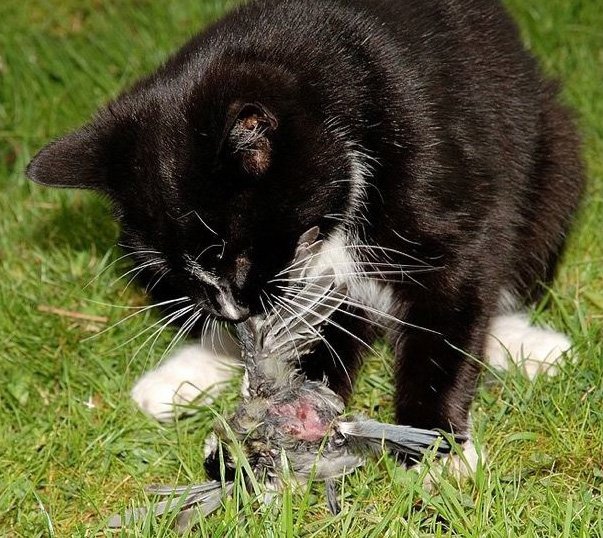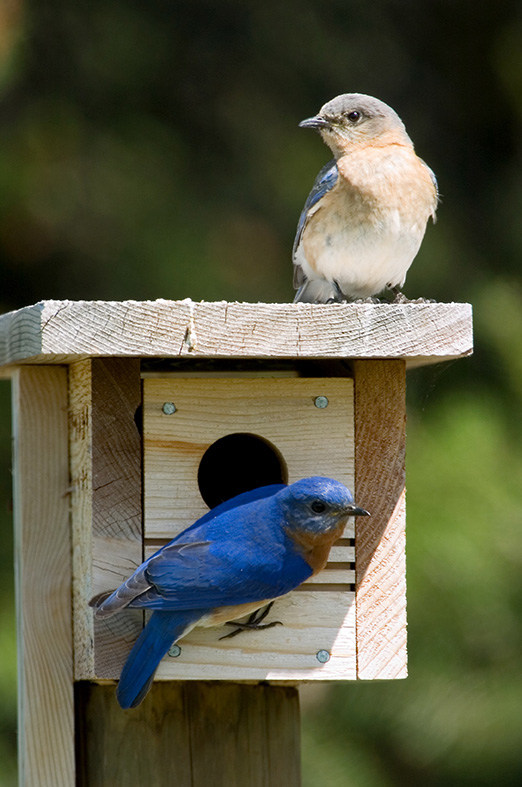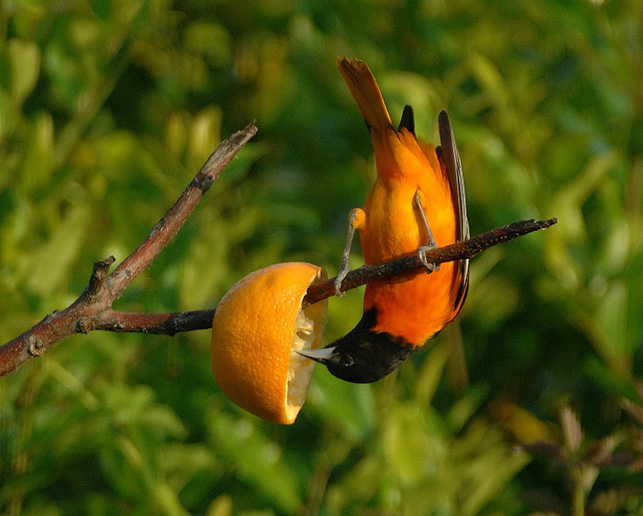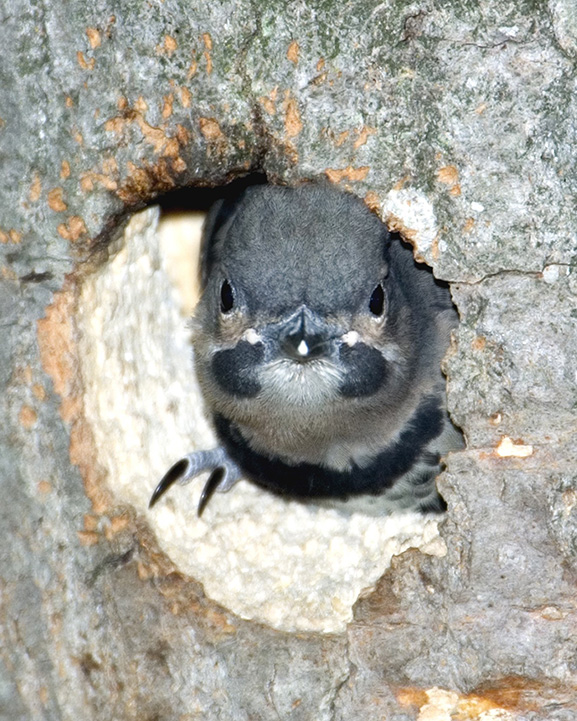Resources
10 Ways to Help
 Use native plants.The most important thing you can do to help your feathered visitors is to incorporate as many native plantings in your yard as possible. Only native plants host the insect abundance required by our migrating and nesting birds. Many birds survive either largely or exclusively on insects, and virtually ALL nesting birds must have insects for their young. These insects provide necessary protein for nestling development. Non-native plants host a fraction of the insects that are supported by native plants.
Use native plants.The most important thing you can do to help your feathered visitors is to incorporate as many native plantings in your yard as possible. Only native plants host the insect abundance required by our migrating and nesting birds. Many birds survive either largely or exclusively on insects, and virtually ALL nesting birds must have insects for their young. These insects provide necessary protein for nestling development. Non-native plants host a fraction of the insects that are supported by native plants.
**NOTE: Use only plants native to your region. For more information about the relationship between native plants, insects and birds, read Bringing Nature Home and Nature’s Best Hope by Douglas Tallamy.
- Window Crashes. According to expert Dr. Daniel Klem, up to a billion birds a year are killed in window crashes annually in North America. Check out abcbirds.org/glass-collisions/ for information on how to prevent window crashes.
- Keep your cats indoors! Domestic and feral cars kill many millions of birds annually. The American Bird Conservancy, National Wildlife Federation, National Audubon and Saving Birds Thru Habitat are just some of the groups calling for keeping kitty indoors - not just because it saves birds, but also because it is healthier for pets. For more information click here.
 Purchase Bird-friendly Coffee. For about two hundred years, coffee was harvested from understory plants growing along mountainside forests in the tropics. Because coffee trees thrived in the understory, products produced from these farms were referred to as “Shade Coffee”. A number of North American migratory songbirds depended on these farms in the winter because of an abundance of food due to the diversity of plants.
Purchase Bird-friendly Coffee. For about two hundred years, coffee was harvested from understory plants growing along mountainside forests in the tropics. Because coffee trees thrived in the understory, products produced from these farms were referred to as “Shade Coffee”. A number of North American migratory songbirds depended on these farms in the winter because of an abundance of food due to the diversity of plants.
In the 1970’s, coffee farming largely changed to “sun plantations,” coffee-only fields at lower elevations. These new farms relied heavily on chemicals like insecticides. With no plant diversity there is no food for birds. Thus “shade coffee” was recommended, meaning that which was still grown on mountainside farms.
However, the term “Shade coffee” implied simply shade. As birders sought out such products, coffee growers presumed that if they need simply add shade, that would be enough – which they did, most frequently non-native eucalyptus trees imported to provide that shade. Such plantations do not offer aid to our tanagers, buntings, warblers and others because they do not include the plant diversity that provides the food for our birds.
If you want to help provide for our wintering warblers and others, seek out coffee from the original mountainside farms. Look for “rain forest” coffee or search https://coopcoffees.coop/.
- Create a thicket. Dense plantings of cedars, serviceberries, dogwoods, viburnums, blackberries and other shrubs and brambles native to your area provide cover, food and nesting sites for a wide variety of birds like buntings, some sparrows and various warblers.
- Make a hummingbird garden. Columbine, cardinal flower, blazing star, New England Aster, spotted jewelweed and other native flowers will attract and feed not only hummers but also butterflies.
 Provide a water feature. Birds need water and you can meet that need with something as simple as a birdbath made from a shallow planter saucer or as complex as an elaborate waterfall, stream and pond setup. The essential element is to keep the water clean for your feathered visitors. Birds, like humans, pass diseases through unclean feeding and watering places.
Provide a water feature. Birds need water and you can meet that need with something as simple as a birdbath made from a shallow planter saucer or as complex as an elaborate waterfall, stream and pond setup. The essential element is to keep the water clean for your feathered visitors. Birds, like humans, pass diseases through unclean feeding and watering places.
- Save dead trees. Most owls, several ducks, all woodpeckers, nuthatches, bluebirds, titmice, some flycatchers, tree swallows, all chickadees, several wrens and two North American warbler species depend on cavities in dead and dying trees for nest sites. While some of the above species accept artificial nesting boxes, many will not. Leaving standing dead timber that does not threaten life, limb or personal property is essential for those birds. If you have no dead trees, add nest boxes.
- Don't spray spiders. Spiders are important bird food, as is their eggs and even their webs (spider webs are made of protein).
- Use the TBBH nest box for bluebirds. If you have bluebirds, protect nestlings from predators and death by heat stress by using the Tree Branch Bluebird House (link to BlueBirdHouse.pdf). Eastern Bluebirds experienced declining populations for decades because of habitat loss and nest site competition with European Starlings and House Sparrows. When people began mounting nest boxes for this beautiful and popular bird, their numbers improved. This is an example of how people can make a positive difference for our nesting bird population. Check out plans for the Tree Branch Bluebird House (link to BlueBirdHouse.pdf) for the safest and most effective housing for bluebirds. Frank Zuern, the Wisconsin "blue birder" who designed this style, tested the temperature differential between the Tree Branch box and the traditional "upright" style by placing a calibrated temperature probe inside each. His research revealed that the temperature inside the traditional box climbed fifteen degrees above ambient. Thus, if the mercury rises to 92 degrees, the temperature inside the upright box topped out at 107 degrees. At 106 degrees, the eggs will addle (become unviable) or nestlings will die of heat stress like a dog in a car. But temperature in his Tree Branch Bluebird Box, only rose two degrees above ambient. Thus, this style prevents nest failure due to heat stress.
 ADDITIONAL HELPFUL INFORMATION
ADDITIONAL HELPFUL INFORMATION
Offer nesting material: Place clean pet fur in a small suet basket and hang on tree limb for birds to use in nest construction. Avoid fur that has been treated with parasiticides – chemicals to kills ticks and fleas– and avoid lint, string or twine as they do not shed water and can soak the nest after a rain.
About feeding birds: Make hummer nectar by using 1 part sugar to 4 parts of water. Dissolve thoroughly. Put only small amounts out and keep unused portion in the fridge. Do NOT add anything to nectar, including food coloring. Never use artificial sweeteners, honey or raw sugar. Offer only small amounts as nectar ferments quickly. Do not add anything to nectar, including food colorings. Do NOT offer commercial hummer foods that often contain chemical preservatives and/or food coloring. Also, do NOT offer jams or jellies to orioles. Yes, the birds love it, but it is unhealthy for them and can get in their feathers preventing them from flying. Keep seed feeders well cleaned and keep seeds fresh.
Accipiters are an increasing problem at feeders, especially during the winter months. They will take up residence at your feeders and take virtually every feeder visitor. Place all feeders near shrubs to provide shelter from avian predators. In a world with declining songbirds, this is an important issue to consider when feeding birds.
